Nursing Assignment: Report on Patient Interview and Clinical Reasoning
VerifiedAdded on 2023/01/13
|7
|1858
|44
Report
AI Summary
This nursing assignment presents a detailed report on a patient interview conducted with a 17-year-old girl dealing with teenage pregnancy. The assignment emphasizes the importance of patient reporting and documentation in healthcare, highlighting the use of a semi-structured interview to gather comprehensive information about the patient's physical and mental health concerns. The report includes a clinical assessment of the patient's vital signs, pregnancy status, and mental health, with a focus on the patient's depression and social stigma. The assignment applies the Levett-Jones clinical reasoning cycle to analyze the patient's condition and determine priority care interventions, including arranging appointments with a psychotherapist and gynecologist. The report concludes with a discussion on the holistic, multidisciplinary approach to patient care and empowerment.
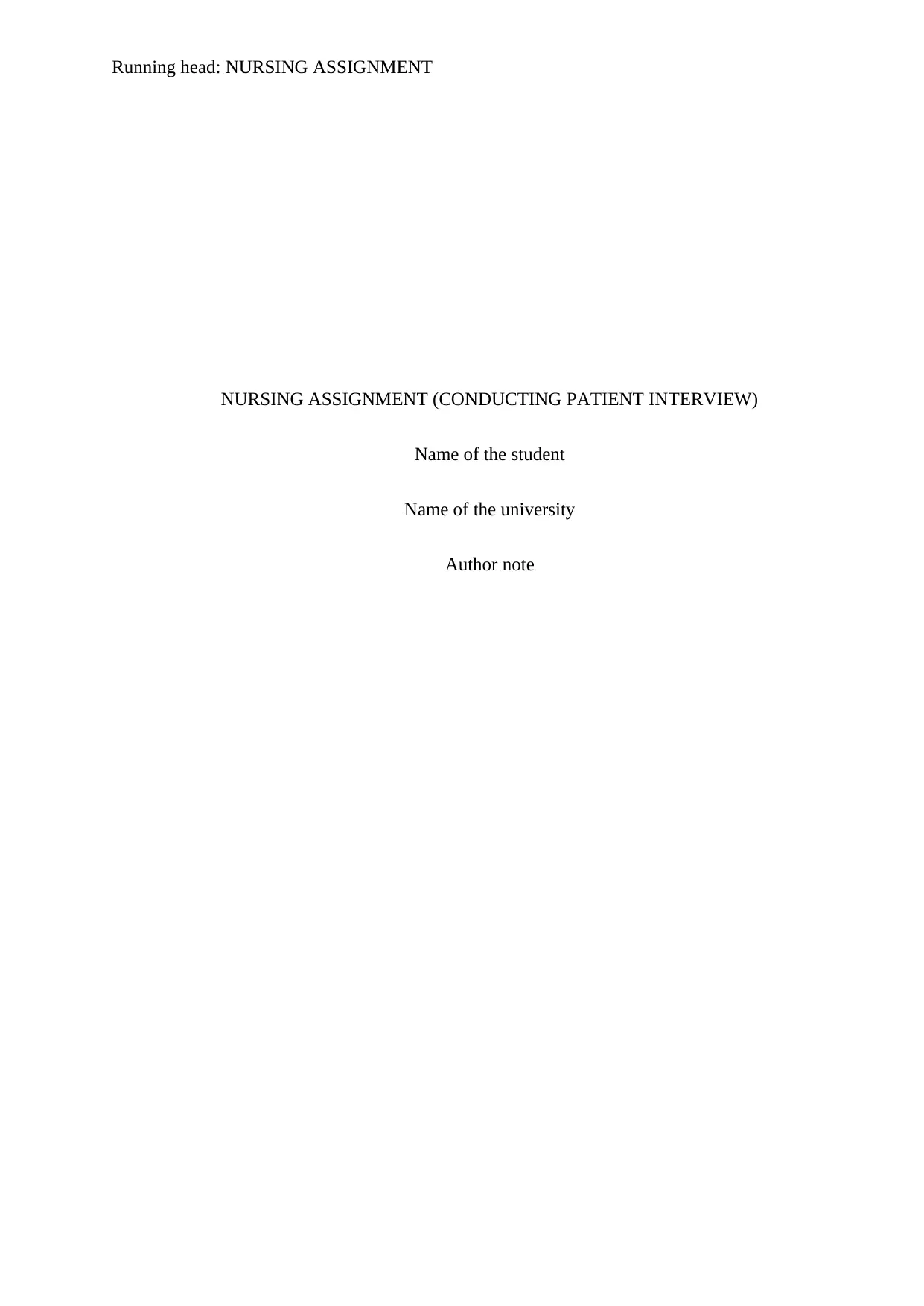
Running head: NURSING ASSIGNMENT
NURSING ASSIGNMENT (CONDUCTING PATIENT INTERVIEW)
Name of the student
Name of the university
Author note
NURSING ASSIGNMENT (CONDUCTING PATIENT INTERVIEW)
Name of the student
Name of the university
Author note
Paraphrase This Document
Need a fresh take? Get an instant paraphrase of this document with our AI Paraphraser
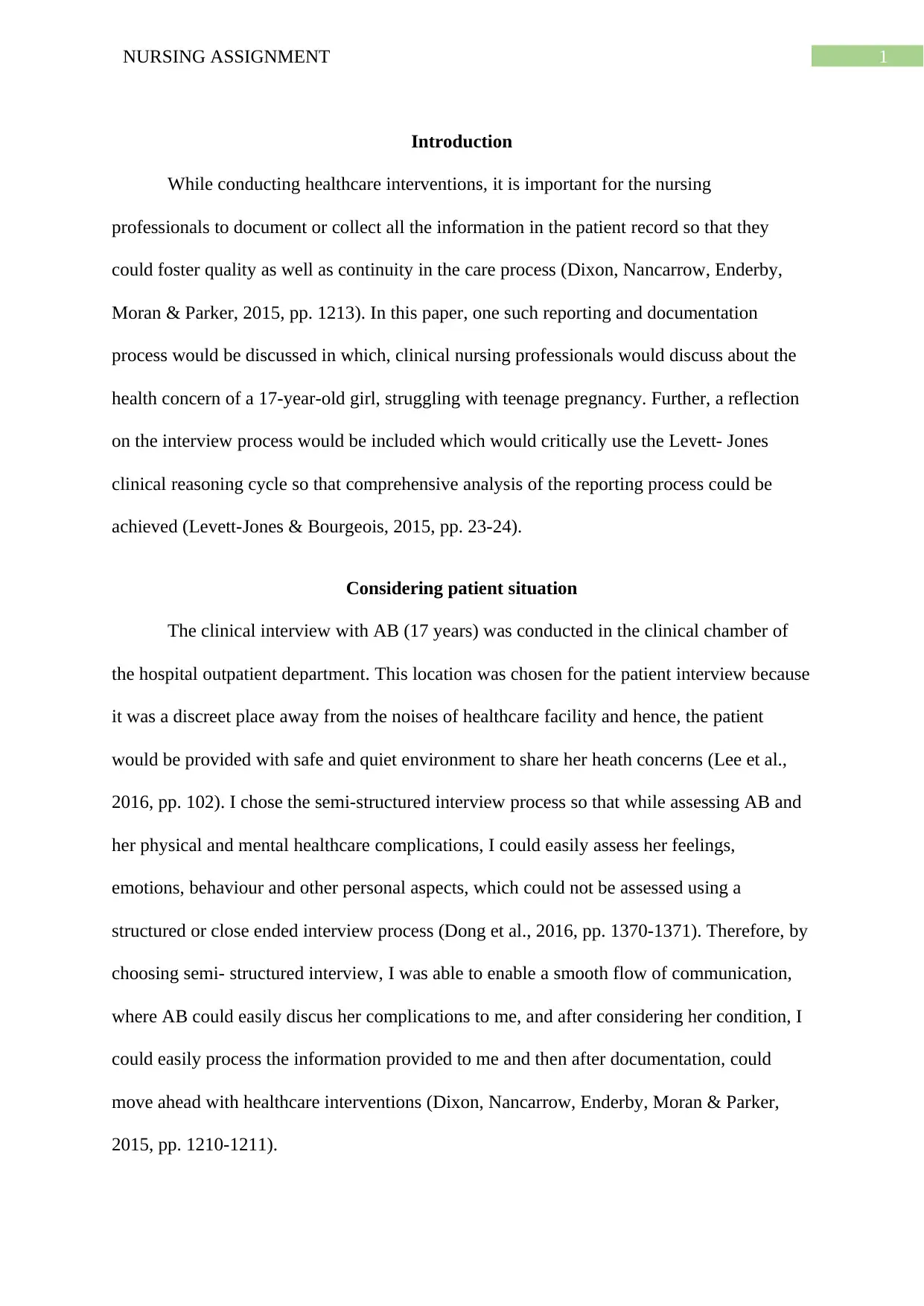
1NURSING ASSIGNMENT
Introduction
While conducting healthcare interventions, it is important for the nursing
professionals to document or collect all the information in the patient record so that they
could foster quality as well as continuity in the care process (Dixon, Nancarrow, Enderby,
Moran & Parker, 2015, pp. 1213). In this paper, one such reporting and documentation
process would be discussed in which, clinical nursing professionals would discuss about the
health concern of a 17-year-old girl, struggling with teenage pregnancy. Further, a reflection
on the interview process would be included which would critically use the Levett- Jones
clinical reasoning cycle so that comprehensive analysis of the reporting process could be
achieved (Levett-Jones & Bourgeois, 2015, pp. 23-24).
Considering patient situation
The clinical interview with AB (17 years) was conducted in the clinical chamber of
the hospital outpatient department. This location was chosen for the patient interview because
it was a discreet place away from the noises of healthcare facility and hence, the patient
would be provided with safe and quiet environment to share her heath concerns (Lee et al.,
2016, pp. 102). I chose the semi-structured interview process so that while assessing AB and
her physical and mental healthcare complications, I could easily assess her feelings,
emotions, behaviour and other personal aspects, which could not be assessed using a
structured or close ended interview process (Dong et al., 2016, pp. 1370-1371). Therefore, by
choosing semi- structured interview, I was able to enable a smooth flow of communication,
where AB could easily discus her complications to me, and after considering her condition, I
could easily process the information provided to me and then after documentation, could
move ahead with healthcare interventions (Dixon, Nancarrow, Enderby, Moran & Parker,
2015, pp. 1210-1211).
Introduction
While conducting healthcare interventions, it is important for the nursing
professionals to document or collect all the information in the patient record so that they
could foster quality as well as continuity in the care process (Dixon, Nancarrow, Enderby,
Moran & Parker, 2015, pp. 1213). In this paper, one such reporting and documentation
process would be discussed in which, clinical nursing professionals would discuss about the
health concern of a 17-year-old girl, struggling with teenage pregnancy. Further, a reflection
on the interview process would be included which would critically use the Levett- Jones
clinical reasoning cycle so that comprehensive analysis of the reporting process could be
achieved (Levett-Jones & Bourgeois, 2015, pp. 23-24).
Considering patient situation
The clinical interview with AB (17 years) was conducted in the clinical chamber of
the hospital outpatient department. This location was chosen for the patient interview because
it was a discreet place away from the noises of healthcare facility and hence, the patient
would be provided with safe and quiet environment to share her heath concerns (Lee et al.,
2016, pp. 102). I chose the semi-structured interview process so that while assessing AB and
her physical and mental healthcare complications, I could easily assess her feelings,
emotions, behaviour and other personal aspects, which could not be assessed using a
structured or close ended interview process (Dong et al., 2016, pp. 1370-1371). Therefore, by
choosing semi- structured interview, I was able to enable a smooth flow of communication,
where AB could easily discus her complications to me, and after considering her condition, I
could easily process the information provided to me and then after documentation, could
move ahead with healthcare interventions (Dixon, Nancarrow, Enderby, Moran & Parker,
2015, pp. 1210-1211).
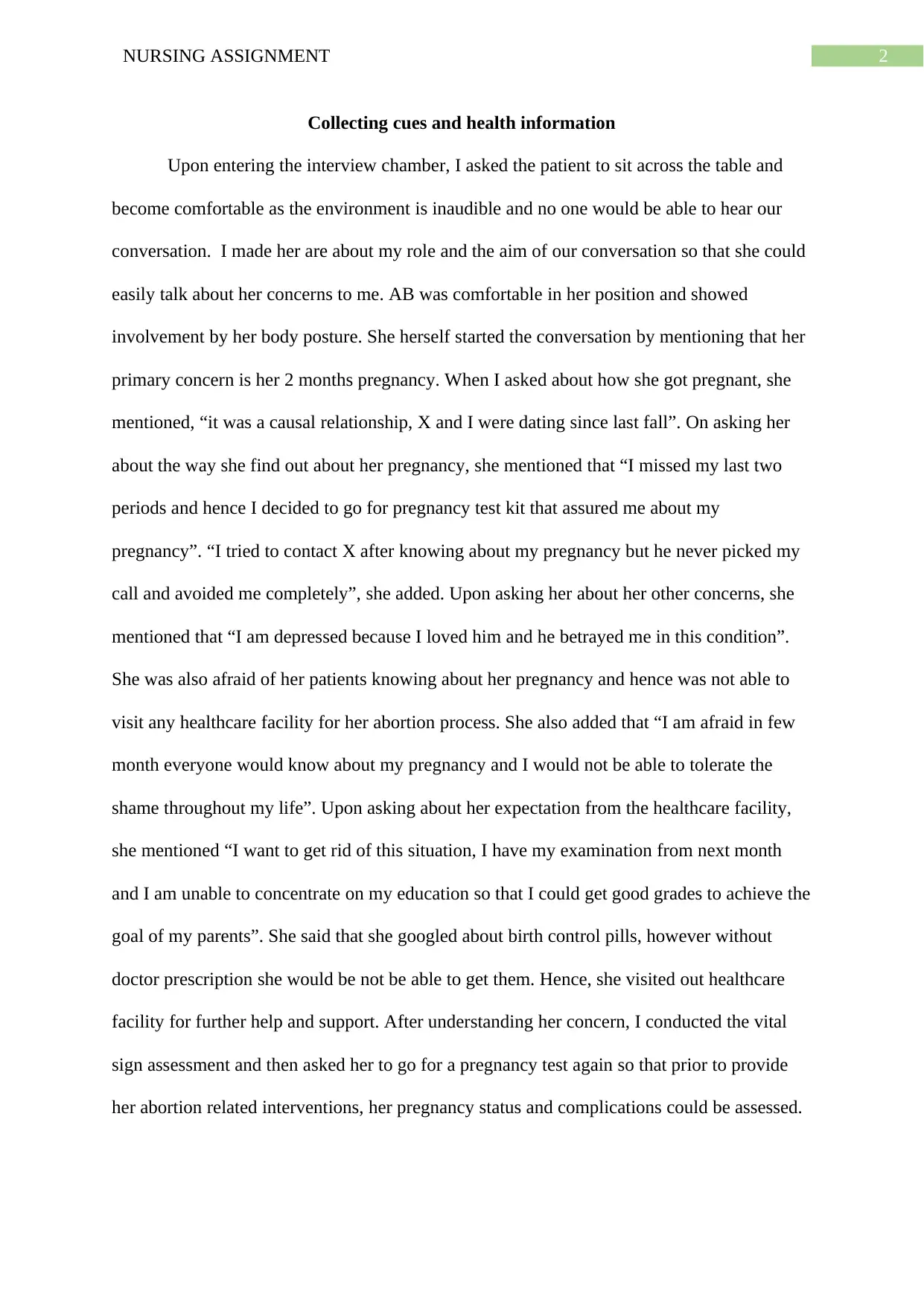
2NURSING ASSIGNMENT
Collecting cues and health information
Upon entering the interview chamber, I asked the patient to sit across the table and
become comfortable as the environment is inaudible and no one would be able to hear our
conversation. I made her are about my role and the aim of our conversation so that she could
easily talk about her concerns to me. AB was comfortable in her position and showed
involvement by her body posture. She herself started the conversation by mentioning that her
primary concern is her 2 months pregnancy. When I asked about how she got pregnant, she
mentioned, “it was a causal relationship, X and I were dating since last fall”. On asking her
about the way she find out about her pregnancy, she mentioned that “I missed my last two
periods and hence I decided to go for pregnancy test kit that assured me about my
pregnancy”. “I tried to contact X after knowing about my pregnancy but he never picked my
call and avoided me completely”, she added. Upon asking her about her other concerns, she
mentioned that “I am depressed because I loved him and he betrayed me in this condition”.
She was also afraid of her patients knowing about her pregnancy and hence was not able to
visit any healthcare facility for her abortion process. She also added that “I am afraid in few
month everyone would know about my pregnancy and I would not be able to tolerate the
shame throughout my life”. Upon asking about her expectation from the healthcare facility,
she mentioned “I want to get rid of this situation, I have my examination from next month
and I am unable to concentrate on my education so that I could get good grades to achieve the
goal of my parents”. She said that she googled about birth control pills, however without
doctor prescription she would be not be able to get them. Hence, she visited out healthcare
facility for further help and support. After understanding her concern, I conducted the vital
sign assessment and then asked her to go for a pregnancy test again so that prior to provide
her abortion related interventions, her pregnancy status and complications could be assessed.
Collecting cues and health information
Upon entering the interview chamber, I asked the patient to sit across the table and
become comfortable as the environment is inaudible and no one would be able to hear our
conversation. I made her are about my role and the aim of our conversation so that she could
easily talk about her concerns to me. AB was comfortable in her position and showed
involvement by her body posture. She herself started the conversation by mentioning that her
primary concern is her 2 months pregnancy. When I asked about how she got pregnant, she
mentioned, “it was a causal relationship, X and I were dating since last fall”. On asking her
about the way she find out about her pregnancy, she mentioned that “I missed my last two
periods and hence I decided to go for pregnancy test kit that assured me about my
pregnancy”. “I tried to contact X after knowing about my pregnancy but he never picked my
call and avoided me completely”, she added. Upon asking her about her other concerns, she
mentioned that “I am depressed because I loved him and he betrayed me in this condition”.
She was also afraid of her patients knowing about her pregnancy and hence was not able to
visit any healthcare facility for her abortion process. She also added that “I am afraid in few
month everyone would know about my pregnancy and I would not be able to tolerate the
shame throughout my life”. Upon asking about her expectation from the healthcare facility,
she mentioned “I want to get rid of this situation, I have my examination from next month
and I am unable to concentrate on my education so that I could get good grades to achieve the
goal of my parents”. She said that she googled about birth control pills, however without
doctor prescription she would be not be able to get them. Hence, she visited out healthcare
facility for further help and support. After understanding her concern, I conducted the vital
sign assessment and then asked her to go for a pregnancy test again so that prior to provide
her abortion related interventions, her pregnancy status and complications could be assessed.
⊘ This is a preview!⊘
Do you want full access?
Subscribe today to unlock all pages.

Trusted by 1+ million students worldwide
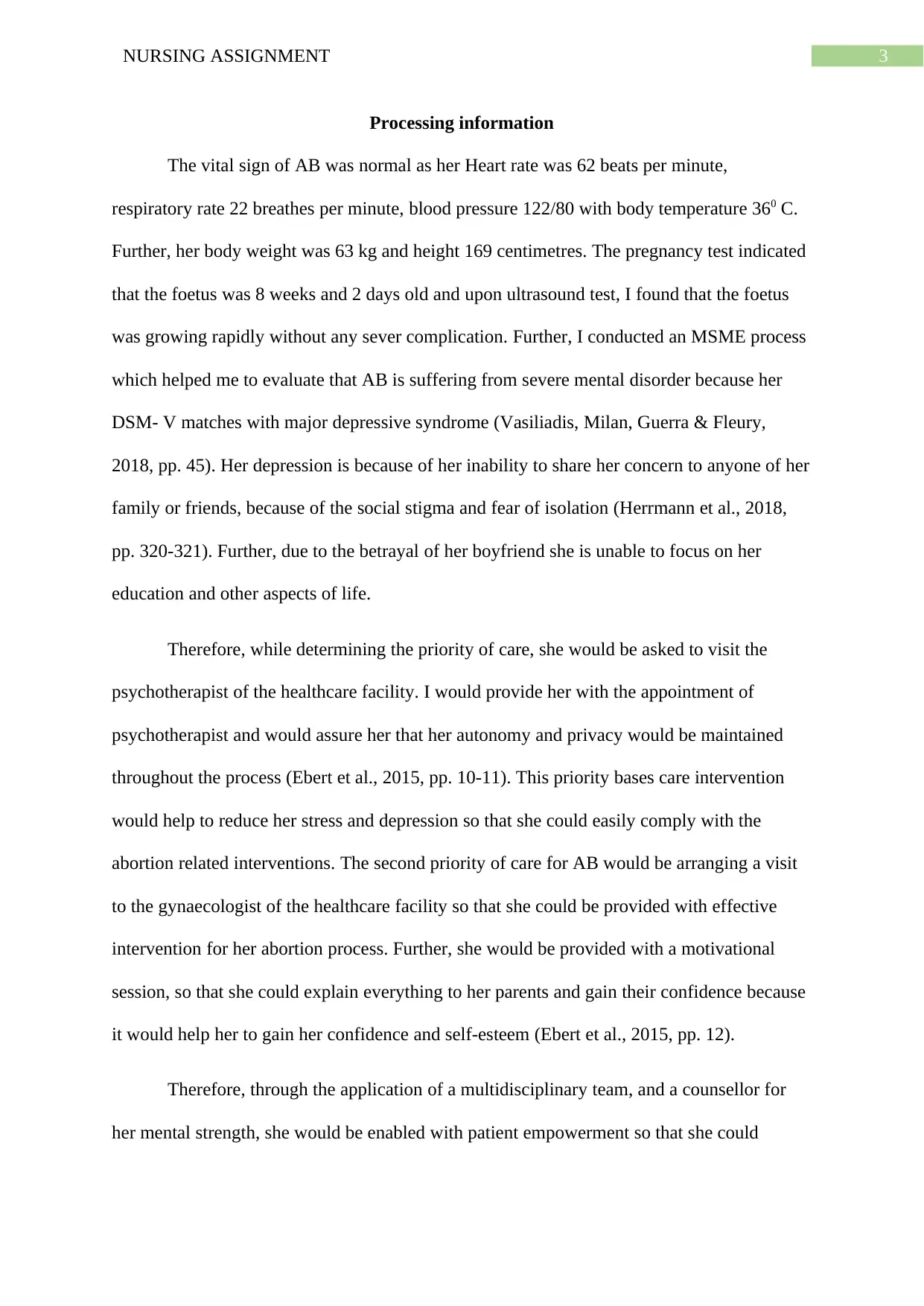
3NURSING ASSIGNMENT
Processing information
The vital sign of AB was normal as her Heart rate was 62 beats per minute,
respiratory rate 22 breathes per minute, blood pressure 122/80 with body temperature 360 C.
Further, her body weight was 63 kg and height 169 centimetres. The pregnancy test indicated
that the foetus was 8 weeks and 2 days old and upon ultrasound test, I found that the foetus
was growing rapidly without any sever complication. Further, I conducted an MSME process
which helped me to evaluate that AB is suffering from severe mental disorder because her
DSM- V matches with major depressive syndrome (Vasiliadis, Milan, Guerra & Fleury,
2018, pp. 45). Her depression is because of her inability to share her concern to anyone of her
family or friends, because of the social stigma and fear of isolation (Herrmann et al., 2018,
pp. 320-321). Further, due to the betrayal of her boyfriend she is unable to focus on her
education and other aspects of life.
Therefore, while determining the priority of care, she would be asked to visit the
psychotherapist of the healthcare facility. I would provide her with the appointment of
psychotherapist and would assure her that her autonomy and privacy would be maintained
throughout the process (Ebert et al., 2015, pp. 10-11). This priority bases care intervention
would help to reduce her stress and depression so that she could easily comply with the
abortion related interventions. The second priority of care for AB would be arranging a visit
to the gynaecologist of the healthcare facility so that she could be provided with effective
intervention for her abortion process. Further, she would be provided with a motivational
session, so that she could explain everything to her parents and gain their confidence because
it would help her to gain her confidence and self-esteem (Ebert et al., 2015, pp. 12).
Therefore, through the application of a multidisciplinary team, and a counsellor for
her mental strength, she would be enabled with patient empowerment so that she could
Processing information
The vital sign of AB was normal as her Heart rate was 62 beats per minute,
respiratory rate 22 breathes per minute, blood pressure 122/80 with body temperature 360 C.
Further, her body weight was 63 kg and height 169 centimetres. The pregnancy test indicated
that the foetus was 8 weeks and 2 days old and upon ultrasound test, I found that the foetus
was growing rapidly without any sever complication. Further, I conducted an MSME process
which helped me to evaluate that AB is suffering from severe mental disorder because her
DSM- V matches with major depressive syndrome (Vasiliadis, Milan, Guerra & Fleury,
2018, pp. 45). Her depression is because of her inability to share her concern to anyone of her
family or friends, because of the social stigma and fear of isolation (Herrmann et al., 2018,
pp. 320-321). Further, due to the betrayal of her boyfriend she is unable to focus on her
education and other aspects of life.
Therefore, while determining the priority of care, she would be asked to visit the
psychotherapist of the healthcare facility. I would provide her with the appointment of
psychotherapist and would assure her that her autonomy and privacy would be maintained
throughout the process (Ebert et al., 2015, pp. 10-11). This priority bases care intervention
would help to reduce her stress and depression so that she could easily comply with the
abortion related interventions. The second priority of care for AB would be arranging a visit
to the gynaecologist of the healthcare facility so that she could be provided with effective
intervention for her abortion process. Further, she would be provided with a motivational
session, so that she could explain everything to her parents and gain their confidence because
it would help her to gain her confidence and self-esteem (Ebert et al., 2015, pp. 12).
Therefore, through the application of a multidisciplinary team, and a counsellor for
her mental strength, she would be enabled with patient empowerment so that she could
Paraphrase This Document
Need a fresh take? Get an instant paraphrase of this document with our AI Paraphraser
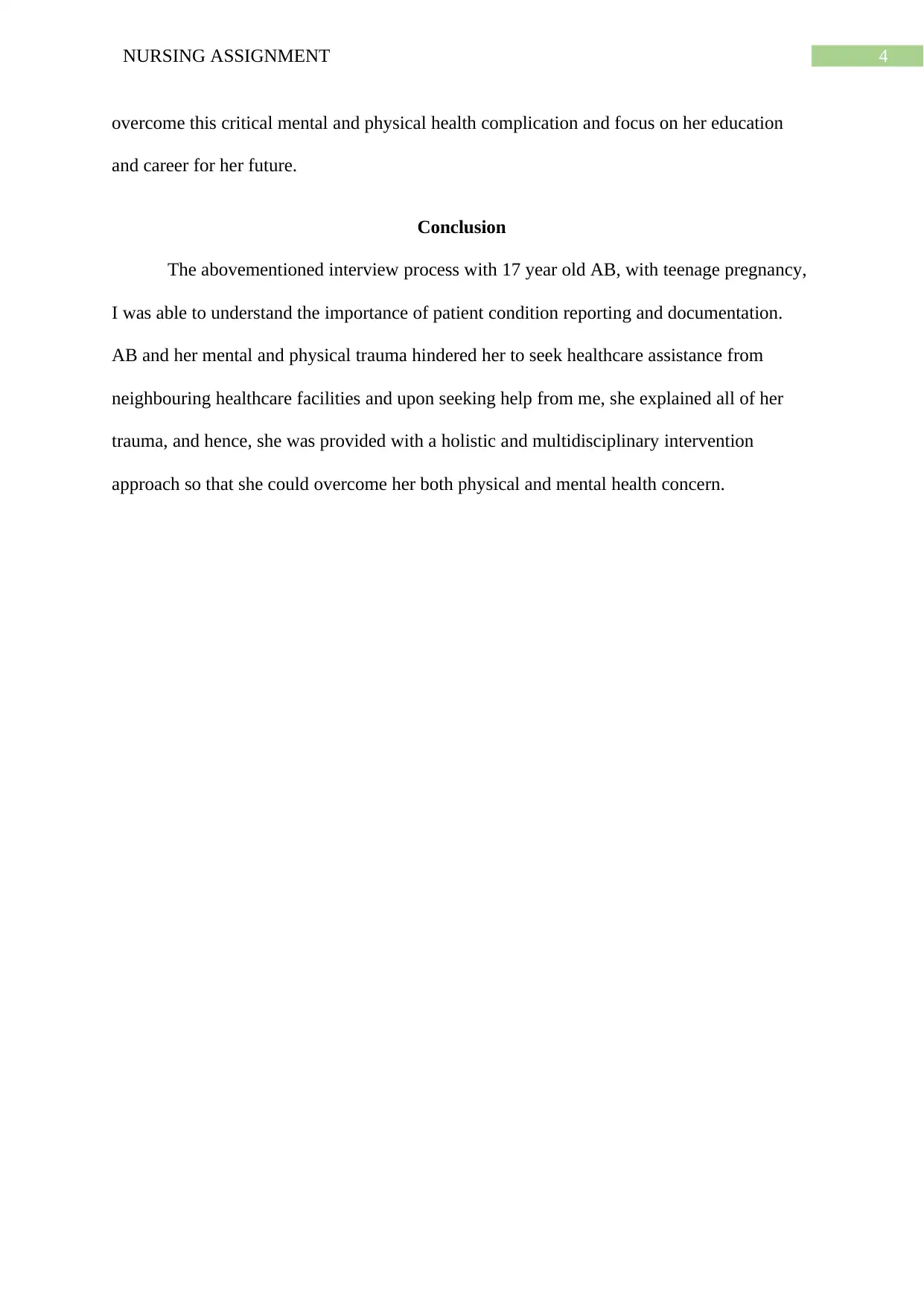
4NURSING ASSIGNMENT
overcome this critical mental and physical health complication and focus on her education
and career for her future.
Conclusion
The abovementioned interview process with 17 year old AB, with teenage pregnancy,
I was able to understand the importance of patient condition reporting and documentation.
AB and her mental and physical trauma hindered her to seek healthcare assistance from
neighbouring healthcare facilities and upon seeking help from me, she explained all of her
trauma, and hence, she was provided with a holistic and multidisciplinary intervention
approach so that she could overcome her both physical and mental health concern.
overcome this critical mental and physical health complication and focus on her education
and career for her future.
Conclusion
The abovementioned interview process with 17 year old AB, with teenage pregnancy,
I was able to understand the importance of patient condition reporting and documentation.
AB and her mental and physical trauma hindered her to seek healthcare assistance from
neighbouring healthcare facilities and upon seeking help from me, she explained all of her
trauma, and hence, she was provided with a holistic and multidisciplinary intervention
approach so that she could overcome her both physical and mental health concern.
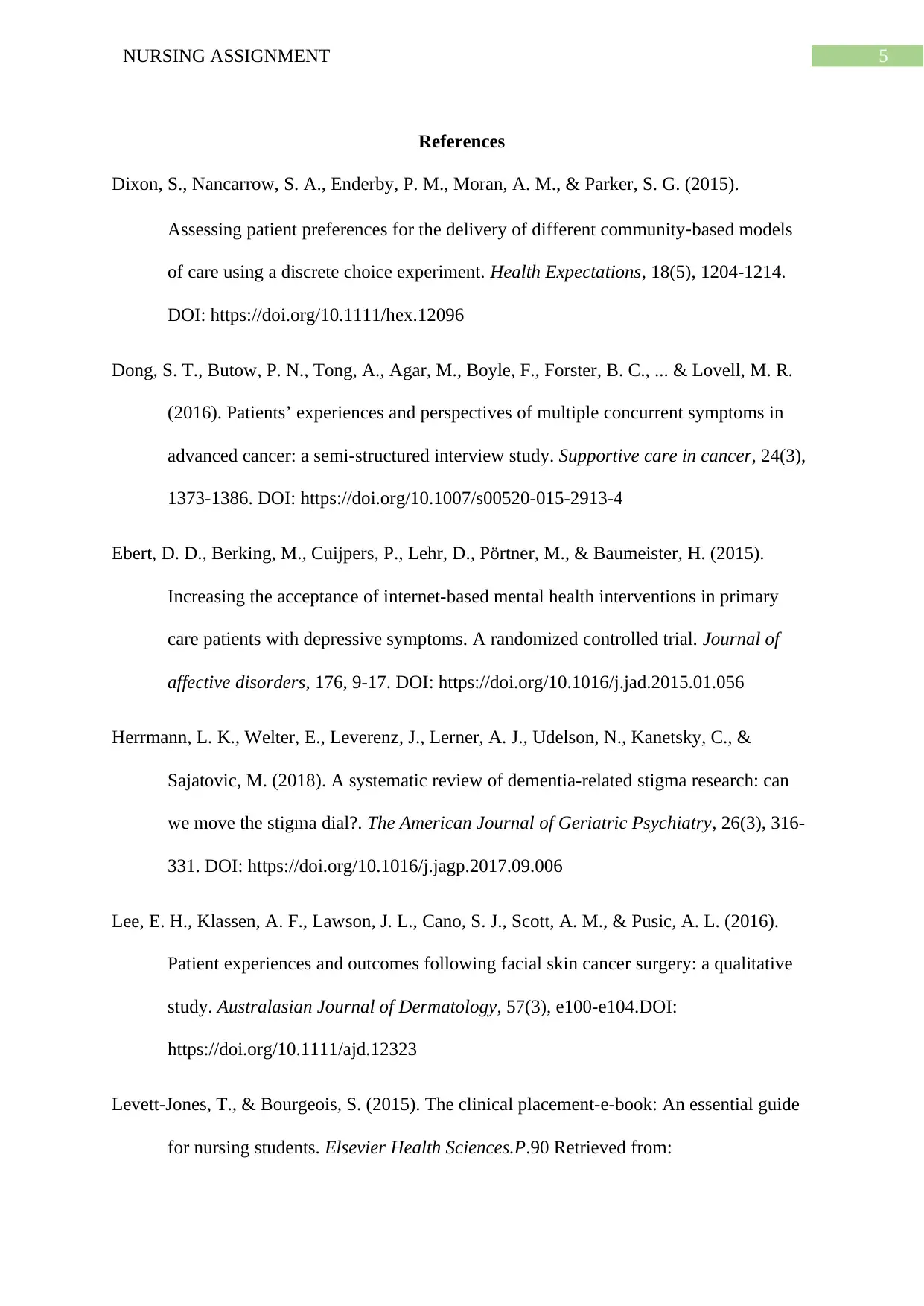
5NURSING ASSIGNMENT
References
Dixon, S., Nancarrow, S. A., Enderby, P. M., Moran, A. M., & Parker, S. G. (2015).
Assessing patient preferences for the delivery of different community‐based models
of care using a discrete choice experiment. Health Expectations, 18(5), 1204-1214.
DOI: https://doi.org/10.1111/hex.12096
Dong, S. T., Butow, P. N., Tong, A., Agar, M., Boyle, F., Forster, B. C., ... & Lovell, M. R.
(2016). Patients’ experiences and perspectives of multiple concurrent symptoms in
advanced cancer: a semi-structured interview study. Supportive care in cancer, 24(3),
1373-1386. DOI: https://doi.org/10.1007/s00520-015-2913-4
Ebert, D. D., Berking, M., Cuijpers, P., Lehr, D., Pörtner, M., & Baumeister, H. (2015).
Increasing the acceptance of internet-based mental health interventions in primary
care patients with depressive symptoms. A randomized controlled trial. Journal of
affective disorders, 176, 9-17. DOI: https://doi.org/10.1016/j.jad.2015.01.056
Herrmann, L. K., Welter, E., Leverenz, J., Lerner, A. J., Udelson, N., Kanetsky, C., &
Sajatovic, M. (2018). A systematic review of dementia-related stigma research: can
we move the stigma dial?. The American Journal of Geriatric Psychiatry, 26(3), 316-
331. DOI: https://doi.org/10.1016/j.jagp.2017.09.006
Lee, E. H., Klassen, A. F., Lawson, J. L., Cano, S. J., Scott, A. M., & Pusic, A. L. (2016).
Patient experiences and outcomes following facial skin cancer surgery: a qualitative
study. Australasian Journal of Dermatology, 57(3), e100-e104.DOI:
https://doi.org/10.1111/ajd.12323
Levett-Jones, T., & Bourgeois, S. (2015). The clinical placement-e-book: An essential guide
for nursing students. Elsevier Health Sciences.P.90 Retrieved from:
References
Dixon, S., Nancarrow, S. A., Enderby, P. M., Moran, A. M., & Parker, S. G. (2015).
Assessing patient preferences for the delivery of different community‐based models
of care using a discrete choice experiment. Health Expectations, 18(5), 1204-1214.
DOI: https://doi.org/10.1111/hex.12096
Dong, S. T., Butow, P. N., Tong, A., Agar, M., Boyle, F., Forster, B. C., ... & Lovell, M. R.
(2016). Patients’ experiences and perspectives of multiple concurrent symptoms in
advanced cancer: a semi-structured interview study. Supportive care in cancer, 24(3),
1373-1386. DOI: https://doi.org/10.1007/s00520-015-2913-4
Ebert, D. D., Berking, M., Cuijpers, P., Lehr, D., Pörtner, M., & Baumeister, H. (2015).
Increasing the acceptance of internet-based mental health interventions in primary
care patients with depressive symptoms. A randomized controlled trial. Journal of
affective disorders, 176, 9-17. DOI: https://doi.org/10.1016/j.jad.2015.01.056
Herrmann, L. K., Welter, E., Leverenz, J., Lerner, A. J., Udelson, N., Kanetsky, C., &
Sajatovic, M. (2018). A systematic review of dementia-related stigma research: can
we move the stigma dial?. The American Journal of Geriatric Psychiatry, 26(3), 316-
331. DOI: https://doi.org/10.1016/j.jagp.2017.09.006
Lee, E. H., Klassen, A. F., Lawson, J. L., Cano, S. J., Scott, A. M., & Pusic, A. L. (2016).
Patient experiences and outcomes following facial skin cancer surgery: a qualitative
study. Australasian Journal of Dermatology, 57(3), e100-e104.DOI:
https://doi.org/10.1111/ajd.12323
Levett-Jones, T., & Bourgeois, S. (2015). The clinical placement-e-book: An essential guide
for nursing students. Elsevier Health Sciences.P.90 Retrieved from:
⊘ This is a preview!⊘
Do you want full access?
Subscribe today to unlock all pages.

Trusted by 1+ million students worldwide
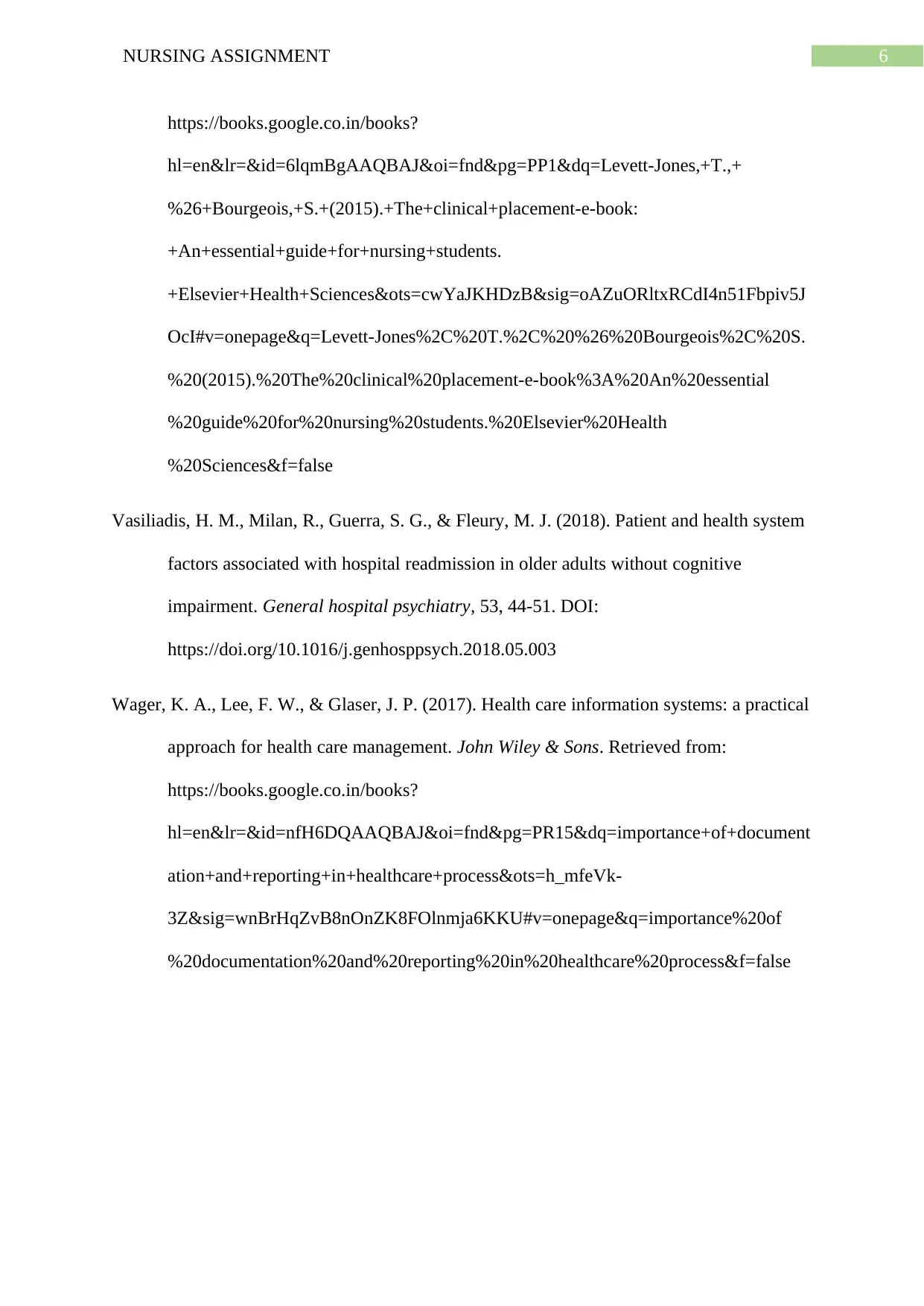
6NURSING ASSIGNMENT
https://books.google.co.in/books?
hl=en&lr=&id=6lqmBgAAQBAJ&oi=fnd&pg=PP1&dq=Levett-Jones,+T.,+
%26+Bourgeois,+S.+(2015).+The+clinical+placement-e-book:
+An+essential+guide+for+nursing+students.
+Elsevier+Health+Sciences&ots=cwYaJKHDzB&sig=oAZuORltxRCdI4n51Fbpiv5J
OcI#v=onepage&q=Levett-Jones%2C%20T.%2C%20%26%20Bourgeois%2C%20S.
%20(2015).%20The%20clinical%20placement-e-book%3A%20An%20essential
%20guide%20for%20nursing%20students.%20Elsevier%20Health
%20Sciences&f=false
Vasiliadis, H. M., Milan, R., Guerra, S. G., & Fleury, M. J. (2018). Patient and health system
factors associated with hospital readmission in older adults without cognitive
impairment. General hospital psychiatry, 53, 44-51. DOI:
https://doi.org/10.1016/j.genhosppsych.2018.05.003
Wager, K. A., Lee, F. W., & Glaser, J. P. (2017). Health care information systems: a practical
approach for health care management. John Wiley & Sons. Retrieved from:
https://books.google.co.in/books?
hl=en&lr=&id=nfH6DQAAQBAJ&oi=fnd&pg=PR15&dq=importance+of+document
ation+and+reporting+in+healthcare+process&ots=h_mfeVk-
3Z&sig=wnBrHqZvB8nOnZK8FOlnmja6KKU#v=onepage&q=importance%20of
%20documentation%20and%20reporting%20in%20healthcare%20process&f=false
https://books.google.co.in/books?
hl=en&lr=&id=6lqmBgAAQBAJ&oi=fnd&pg=PP1&dq=Levett-Jones,+T.,+
%26+Bourgeois,+S.+(2015).+The+clinical+placement-e-book:
+An+essential+guide+for+nursing+students.
+Elsevier+Health+Sciences&ots=cwYaJKHDzB&sig=oAZuORltxRCdI4n51Fbpiv5J
OcI#v=onepage&q=Levett-Jones%2C%20T.%2C%20%26%20Bourgeois%2C%20S.
%20(2015).%20The%20clinical%20placement-e-book%3A%20An%20essential
%20guide%20for%20nursing%20students.%20Elsevier%20Health
%20Sciences&f=false
Vasiliadis, H. M., Milan, R., Guerra, S. G., & Fleury, M. J. (2018). Patient and health system
factors associated with hospital readmission in older adults without cognitive
impairment. General hospital psychiatry, 53, 44-51. DOI:
https://doi.org/10.1016/j.genhosppsych.2018.05.003
Wager, K. A., Lee, F. W., & Glaser, J. P. (2017). Health care information systems: a practical
approach for health care management. John Wiley & Sons. Retrieved from:
https://books.google.co.in/books?
hl=en&lr=&id=nfH6DQAAQBAJ&oi=fnd&pg=PR15&dq=importance+of+document
ation+and+reporting+in+healthcare+process&ots=h_mfeVk-
3Z&sig=wnBrHqZvB8nOnZK8FOlnmja6KKU#v=onepage&q=importance%20of
%20documentation%20and%20reporting%20in%20healthcare%20process&f=false
1 out of 7
Related Documents
Your All-in-One AI-Powered Toolkit for Academic Success.
+13062052269
info@desklib.com
Available 24*7 on WhatsApp / Email
![[object Object]](/_next/static/media/star-bottom.7253800d.svg)
Unlock your academic potential
Copyright © 2020–2025 A2Z Services. All Rights Reserved. Developed and managed by ZUCOL.





